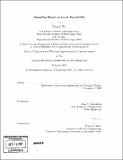| dc.contributor.advisor | Alan V. Oppenheim. | en_US |
| dc.contributor.author | Wei, Dennis | en_US |
| dc.contributor.other | Massachusetts Institute of Technology. Dept. of Electrical Engineering and Computer Science. | en_US |
| dc.date.accessioned | 2008-09-03T14:37:55Z | |
| dc.date.available | 2008-09-03T14:37:55Z | |
| dc.date.copyright | 2007 | en_US |
| dc.date.issued | 2007 | en_US |
| dc.identifier.uri | http://hdl.handle.net/1721.1/42112 | |
| dc.description | Thesis (M. Eng.)--Massachusetts Institute of Technology, Dept. of Electrical Engineering and Computer Science, 2007. | en_US |
| dc.description | Includes bibliographical references (p. 105-106). | en_US |
| dc.description.abstract | The sampling of continuous-time signals based on local bandwidth is considered in this thesis. In an intuitive sense, local bandwidth refers to the rate at which a signal varies locally. One would expect that signals should be sampled at a higher rate in regions of higher local bandwidth, and at a lower rate in regions of lower local bandwidth. In many cases, sampling signals based on local bandwidth can yield more efficient representations as compared with conventional uniform sampling, which does not exploit local signal characteristics. In the first part of the thesis, a particular definition for a linear time-varying lowpass filter is adopted as a potential model for local bandwidth. A sampling and reconstruction method permitting consistent resampling is developed for signals generated by such filters. The method does not generally result in perfect reconstruction except for a special class of self-similar signals. However, the reconstruction error is shown to decrease with the variation in the cut-off frequency of the filter. In the second part of the thesis, a definition for local bandwidth based on the time-warping of globally bandlimited signals is reviewed. Using this definition, a method is developed for sampling and reconstructing signals according to local bandwidth. The method employs a time-warping to minimize the energy of a signal above a given maximum frequency. A number of techniques for determining the optimal time-warping are examined. | en_US |
| dc.description.statementofresponsibility | by Dennis Wei. | en_US |
| dc.format.extent | 106 p. | en_US |
| dc.language.iso | eng | en_US |
| dc.publisher | Massachusetts Institute of Technology | en_US |
| dc.rights | M.I.T. theses are protected by
copyright. They may be viewed from this source for any purpose, but
reproduction or distribution in any format is prohibited without written
permission. See provided URL for inquiries about permission. | en_US |
| dc.rights.uri | http://dspace.mit.edu/handle/1721.1/7582 | en_US |
| dc.subject | Electrical Engineering and Computer Science. | en_US |
| dc.title | Sampling based on local bandwidth | en_US |
| dc.type | Thesis | en_US |
| dc.description.degree | M.Eng. | en_US |
| dc.contributor.department | Massachusetts Institute of Technology. Department of Electrical Engineering and Computer Science | |
| dc.identifier.oclc | 226372098 | en_US |
